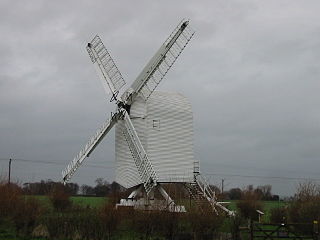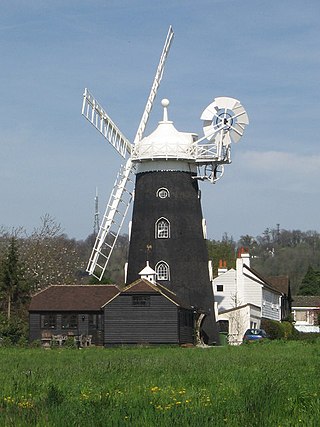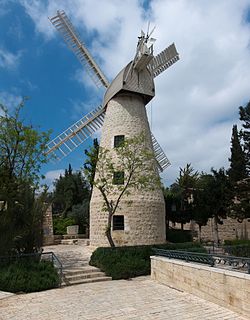This is a partial timeline of Zionism in the modern era, since the start of the 16th century.
The Lovers of Zion, also Hovevei Zion or Hibbat Zion, were a variety of proto-Zionist organizations founded in 1881 in response to the anti-Jewish pogroms in the Russian Empire and were officially constituted as a group at a conference led by Leon Pinsker in 1884.

Kerem Avraham, in English Abraham's Vineyard, is a neighbourhood near Geula in central Jerusalem, founded in 1855. It is bounded by Malkhei Yisrael Street, Yechezkel Street, Tzefanya Street, and the Schneller Compound.

Jerusalem's population size and composition has shifted many times over its 5,000 year history.

Mishkenot Sha'ananim was the first Jewish settlement built outside the walls of the Old City of Jerusalem, on a hill directly across Mount Zion. It was built in 1859–1860. This guesthouse was one of the first structures to be built outside the Old City, the others being Kerem Avraham, the Schneller Orphanage, Bishop Gobat school, and the Russian Compound.

The perushim were Jewish disciples of the Vilna Gaon, Elijah ben Solomon Zalman, who left Lithuania at the beginning of the 19th century to settle in the Land of Israel, which was then part of Ottoman Syria. They were from the section of the community known as misnagdim in Lithuania.

Yemin Moshe is a historic neighborhood in Jerusalem, overlooking the Old City.

Nachlaot is a cluster of 23 courtyard neighborhoods in central Jerusalem surrounding the Mahane Yehuda Market. It is known for its narrow, winding lanes, old-style housing, hidden courtyards and many small synagogues.

Chillenden windmill is a grade II* listed open-trestle post mill north of Chillenden, Kent, England. It is the last post mill built in Kent.

New Mill is a Grade II listed smock mill in Northbourne, Kent, England that was built in 1848 and which has been converted to residential accommodation.

Davison's Mill, also known as Stelling Minnis Windmill, is a Grade I listed smock mill in Stelling Minnis, Kent, England that was built in 1866. It was the last windmill working commercially in Kent when it closed in the autumn of 1970.

Wray Common Mill is a grade II* listed tower mill at Reigate, Surrey, England which has been converted to residential use.
The Old Yishuv were the Jewish communities of the region of Palestine during the Ottoman period, up to the onset of Zionist aliyah waves, and the consolidation of the New Yishuv by the end of World War I. Unlike the New Yishuv, characterized by secular and socialist ideologies promoting labor and self-sufficiency, the Old Yishuv primarily consisted of religious Jews who relied on external donations (halukka) for support.
Kollel Shomrei haChomos is a financial charity institute or kollel set up to support the community of Hungarian-Jews who emigrated to the Holy Land, hence it is called by many the Hungarian Kollel. The Hungarian Jews separated themselves in 1858 from its mother institute Kolel Chibas Yerushalayim which at one point in time included the Jewish communities of the entire Austrian Hungarian Kingdom. Kolel Chibas Yerushalayim was itself a breakaway from the original Kolel Perushim, established by the students of the Vilna Gaon. Two leading Hungarian rabbis were appointed as the "Nesyim" or "Presidents of the Kolel, Avraham Shmuel Binyamin Sofer, author of Ketav Sofer, and Meir Eisenstein. In honor of these two leaders the Hungarian Kolel was also called "House of Sofer and Meir"

De Hoop is a smock mill in Dokkum, Friesland, Netherlands which was built in 1849 and has been restored to working order. The mill is listed as a Rijksmonument, number 13186.
Avraham Wolfensohn (1783–1855) was a Jewish rabbi, Talmudic judge and leader of the Ashkenazi community in Safed, Ottoman Galilee in the mid-19th century.

The expansion of Jerusalem outside of the Old City walls, which included shifting the city center to the new neighborhoods, started in the mid-19th century and by the early 20th century had entirely transformed the city. Prior to the 19th century, the main built up areas outside the walls were the complex around King David's Tomb on the southern Mount Zion, and the village of Silwan.

Sir Moses Haim Montefiore, 1st Baronet, was a British financier and banker, activist, philanthropist and Sheriff of London. Born to an Italian Sephardic Jewish family based in London, after he achieved success, he donated large sums of money to promote industry, business, economic development, education and health among the Jewish community in the Levant. He founded Mishkenot Sha'ananim in 1860, the first Jewish settlement outside the Old City of Jerusalem.

The bronze bust of former British prime minister Sir Winston Churchill at Mishkenot Sha’ananim, Jerusalem was created by portrait sculptor Oscar Nemon. Anthony Rosenfelder, together with MK Isaac Herzog, initiated the process of erecting the bust of Churchill in Jerusalem.
Aaron Hershler was a Hungarian-born Jew considered the first national Jewish martyr in the Jewish-Arab conflict. While attempting to intervene in a robbery at his family's home in Mishkenot Sha'ananim, the first Jewish neighborhood outside the walls of the Old City of Jerusalem, Hershler was shot 12 times, dying 5 days later.



















